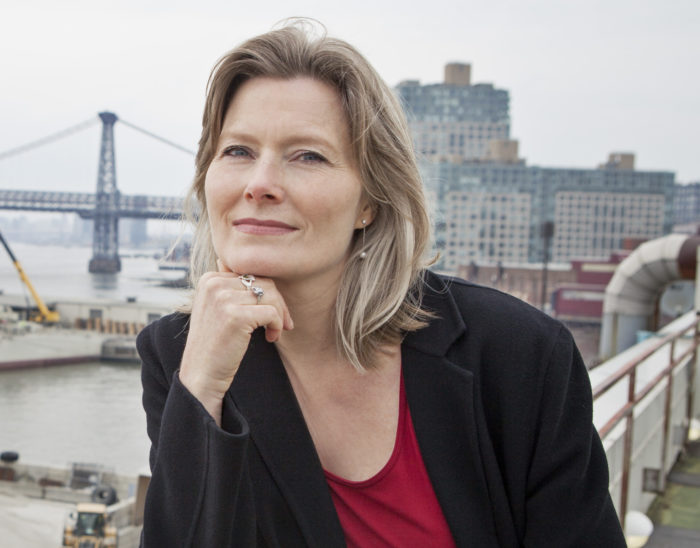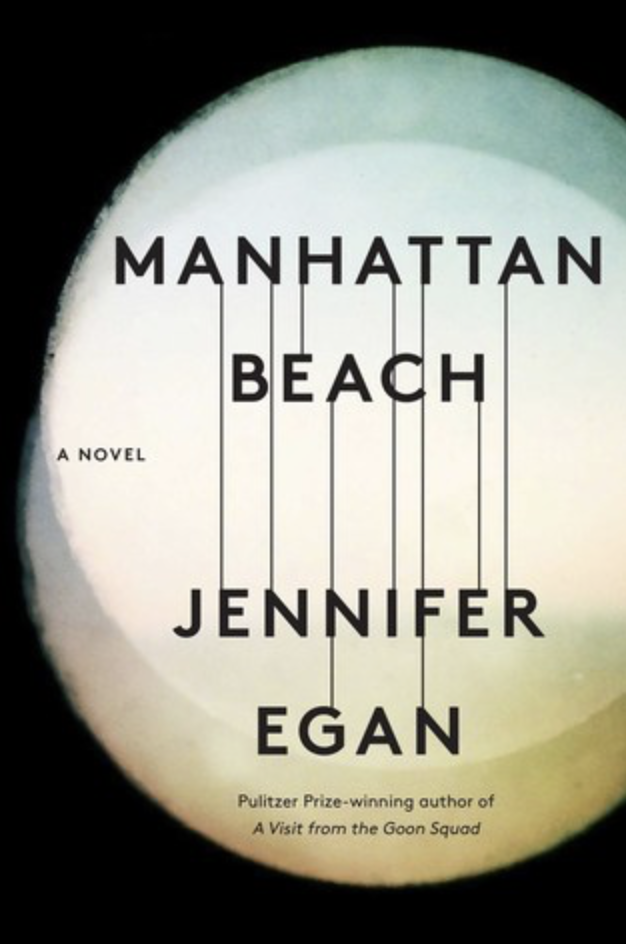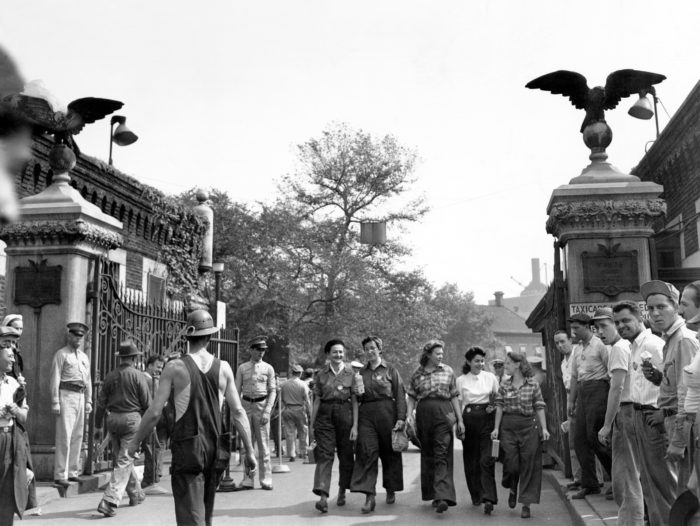In a departure from her earlier work, including the Pulitzer-winning A Visit from the Goon Squad, Brooklyn-based novelist Jennifer Egan plunged into the realm of historical fiction with her new book, Manhattan Beach. The young protagonist, Anna Kerrigan, becomes the first woman to work as a diver at the Brooklyn Navy Yard during World War II. While the story stays faithfully in the past, readers will see inescapable parallels to today’s headlines about women in the workforce. The main character’s pivotal moment: “As Anna returned their cutlery to the canteen, she felt a seismic rearrangement within herself. It was clear to her now she had always wanted to be a diver, to walk along the bottom of the sea. But this certainty was fraught with worry that she would be denied.”
Manhattan Beach, published Oct. 3, has been an immediate hit, leaping onto the New York Times bestseller list, drawing glowing reviews and a New Yorker profile. For Egan, who lives in Fort Greene with her husband and two teenage sons, the extensive research for the book was often close to home and full of discoveries. She shared her insights about historic Brooklyn in an interview with The Bridge:
How did you decide on the time and place of the novel?
I think the origin of the curiosity about New York in wartime started with 9/11. The city really did feel like a war zone for several months after that. You couldn’t get into lower Manhattan; it was a kind of crazy, instantaneous transformation of a world that I knew pretty well, having been living here since 1987.
So I think that led me to be just curious about another war era, World-War-II-era New York, when the fear of an invasion or an air invasion was really quite real, even though in retrospect those things were actually very unlikely to have happened.
Another issue that became of interest to me as a result of 9/11 was just American global power per se. I felt instinctively–I think we all did–that the events of 9/11 constituted an impact on that power. And so that led me to be curious about the genesis of that power, and what it felt like to be in the midst of the moment when it really began to amass.
Then the research kind of led to more research. I was not thinking about Brooklyn specifically at the beginning, but no sooner did I start looking at photographs of New York in the ’40s by Andreas Feininger that I was just struck by the all-importance of the waterfront. And as soon as I began thinking about the waterfront and doing research on the Port of New York during World War II, I immediately found myself in the Brooklyn Navy Yard because it was incredibly important. It was the largest builder and repairer of allied ships during World War II. I had been living next door to it for several years by then and had actually no idea of that.
The Navy Yard today is digitally driven, but the place you describe in the book is very analog, a place of sights and sounds and smells. Did you purposefully evoke that based on your research?
Well, any physical experience, I would argue, is analog. If you’re in a place, it’s not a digital experience. It’s just that our definition of what being in a place is has changed over time. Even now, the Navy Yard is a very sensory place. It still has that totally industrial, waterfront feel.
I think one of the things that drew me to that period, because I’ve been very focused on technology for my last three books, was a sort of freedom in moving to a time when digital experience for all intents and purposes did not exist. There were movies, and people went to them passionately, but life was really screen free. And that was really a pleasure for me to experience as a writer. I think it was good for me to get back to a kind of storytelling that involved big, crazy adventures right on the page, rather than off-screen.

Speaking of 1940s repartee, Egan said, “When I read correspondence of the time, the lingo was identical to what I heard in the movies.” (Photo by Pieter M. Van Hattem/Courtesy of Scribner)
One vivid thing in the book is when Anna is putting on the diving suit, ironically called the “dress,” which is extremely heavy and uncomfortable. How did you research that?
Well, I actually was able to wear the dress myself. So I had a first-hand experience with that. In the course of my research, I was welcomed by a Veterans Association of Army Divers. They have a very well-organized veterans group that meets every other year. And they invited me to come along in 2009. Just to give you an idea of how long I’ve been researching this, I hadn’t even finished A Visit from the Goon Squad when I did this.
One of the attractions of attending these reunions is that any diver, any veterans who would like, are able to wear the old equipment and dive in a tank. So I was able to be dressed in the Mark V. Obviously I did not dive. I’ve never even scuba dived. But I wore it and so I really did experience the excruciating sensations of trying to walk in 200 lbs. It is not pleasant.
I had a chance on that visit to interview a World War II diver named Jim Kennedy, who actually dove in the harbor of Cherbourg, helping to clear all the detritus that the Germans exploded there to try to make the port unusable for the Allies. I asked if he had ever encountered any female divers in his work. And he said that he had met a female Russian diver in Cherbourg. Of course, Russian women did everything during the war–they were pilots, doctors, and divers too, apparently. I think that may have been the first moment that I considered writing about a female diver.
So there wasn’t necessarily a real-life female diver at the Navy Yard, but there could have been?
Absolutely, I can almost certainly say there were not. But the thing about wartime, and another reason why it was such a fun experience to write about a young woman at that time, is that all kinds of things that would never have happened under normal circumstances not only became possible but became necessary.
The women were urged into jobs they had been told all their lives they could never do. So it was a very topsy-turvy sort of liminal period. And that interested me a lot. And therefore I felt absolutely within my rights to write about a female diver and an African-American diver. In fact, neither of those is very likely.

In researching the book, the author developed a theory about why gangsters had an aura of romance and even respect
The war empowered women, and then suddenly the war was over and things regressed. Was there lasting impact?
For sure, the immediate affect was that it went [away]. And then there was a kind of a widely acknowledged and in some ways a propaganda effort to romanticize domesticity for women in the ’50s. But it didn’t really last too long, because then the women’s movement came to be in the ’60s, involving more the children of Anna’s generation than that generation in and of itself. And I think it’s fair to say that [the] possibilities simply could not be forgotten.
Some of the women I talked to, and worked in the Navy Yard, had pretty poignant stories. There was one woman in particular, a welder, who was so proud of her skills. And she was incredibly small, and wiry. I think she probably was not even five feet tall. She was incredibly valuable working on ships where the spaces were very tight. She could get almost anywhere and weld there.
So after the war, she still needed to work. Most women I talked to were working-class women who did need to hold jobs after the war. And in fact had held jobs before doing industrial work. They had been phone operators or maids or whatever. Anyway, she tried to get welding work and she was laughed at repeatedly, out-and-out laughed at by the men that she applied to. And she was furious about it. And it stayed with her till her last days.
In the book, the repartee is so reminiscent of 1940s movies. How did you get the lingo down?
I very explicitly wanted to use genre in this book. I wasn’t quite sure how I was going to do it, but I was interested first of all in just the history of sea stories, which is kind of a genre unto itself. But then also I was interested in using the snappy repartee of the time. One thing that’s interesting is that some reviewers think I did that by accident and that the stylization of the dialogue is sort of “unrealistic.”
It was certainly not accidental. When I read correspondence of the time, the lingo was identical to what I heard in the movies. I read a long correspondence, scores and scores of letters between a woman and her husband. They had met at the Navy Yard and then he joined the Navy. And they went back and forth. And it was exactly that kind of tone going both ways. I also remember letters between my grandparents. And once again it’s full of lots and lots of cracks and a lot of language that I think may seem to a contemporary ear to be movie-esque.
Maybe one reason it was in the movies is that [it was] actually the way people talked, a stylized repartee that they utilized knowingly in order to engage in a certain kind of snappy interaction. But in any case it certainly was not limited to the movies and pulp detective fiction.
Brooklyn was diverse back in those days, but in a different way. You summoned up the prejudices of the time, which were among a bunch of different kinds of white people. The gangster Dexter Styles thinks, “You wanted a mick to help you dream up schemes, but in the end you needed a wop or a Jew or a Polack to execute them.” Is that how Brooklynites pigeonholed one another in that era?
Yes, and I ventured into that with a knowledge that some people might not like to read things like that. But there was absolutely no way around it because, once again, that is simply how people talked, as far as I can tell. It’s not even that these things were always critical, but that ethnic affinity was usually identified right at the outset in describing a person.

After their first day of work at the Brooklyn Navy Yard in 1942, women apprentices walk through the Sands Street Gate and head for home (Photo by the New York Times/Redux)
I interviewed a lot of elderly New Yorkers with great memories that I can only aspire to when I am in my ’80s. One of them, the artist Alfred Leslie, pointed out an irony, which is that people were much more focused on ethnicity and yet, according to him, there was less prejudice. As if to say nowadays we sort of pretend we don’t see any of that and yet, maybe partly because it’s so buried, there is a more kind of bad feeling about it.
I know that when my husband was first reading this draft, and he’s Jewish, [he read the] mention of someone needing to go to the shyster to borrow money and he really did a double take. He’s like, “What? Wait a minute, Jenny, that’s not going to cut it.” But then as he kept reading he realized that no one was exempt and everyone is categorized in this way by everyone else and put into some sort of ethnic group.
The book takes us into the world of gangsters. From your research, how were they different from those we see in the movies?
Well, I bumped up against organized crime everywhere I turned. There was no way to go near the waterfront without encountering it. I read a lot of interviews and I remember just certain things would stick in my mind. There was one guy who worked at the Navy Yard, but he was also a musician, I think a trumpet player. He talked about how he played at certain clubs outside the Flatlands, out near where JFK airport is now, which [he indicated] were mob-controlled. Basically, he said, “Well, I don’t care what they do with their time, they’re good tippers and I like working for them.”
I talked with the eminence of a tugboat firm, probably his late 80s now, who talks about how the Irish waterfront was so unbelievably corrupt. Of course, we all know that anyway because of the movie On the Waterfront, which is very careful not to identify its characters ethnically. But the story of that movie is taken directly from an exposé, a series of articles exposing the corruption of the Irish waterfront and its unions on the West Side piers. So I couldn’t get away from it and I didn’t want to.
One thing that I also came to understand, [the] association with gangsters in the 20th century was sort of romantic. But I wasn’t sure why. And as I read more, I came to realize that in a way the answer was obvious, which was prohibition. When alcohol became illegal and everyone still wanted to drink, organized crime really stepped in where the government had given up its control over the movement and sale of alcohol. And therefore organized crime became a more accepted part of life society than I think it had been before, and certainly than it is now.
So you had these figures like Frank Costello, who was a mob boss living in a fancy building on Central Park West, with well-known people associating with them. And there were a lot of mob-affiliated people who owned nightclubs, dating from prohibition when a lot of nightclubs were speakeasies. Naturally these men hoped to actually make the jump into mainstream society. I think a lot of criminals are drawn to criminality because it gives them a hope of upward mobility that they might not have otherwise.
How did you pick Manhattan Beach as Dexter’s home?
Well, it’s a funny way that I came to it. I wrote that first scene without exactly knowing where it was. I knew that there had once been very fancy and beautiful houses where Coney Island is. I mean basically along that strip, also Brighton Beach.
So I had sort of invented a land in my mind where some of those beautiful houses still existed. But I wasn’t sure that that place was real when I wrote that scene. And so then when I brought it to my writing group, a guy whose work I’ve been enjoying for many years, David Rosenstock, who grew up there, said, “Oh, you’re writing about Manhattan Beach, where the beautiful houses are.”
I thought, Ah, now I’m almost ashamed to admit I had really never heard of it. The only Manhattan Beach that I knew of was the one in California. So when I read more about Manhattan Beach, it was almost uncanny how perfect it was for what I was trying to do. Not only because it is sort of remote–it’s very hard to reach by subway–but because of its history and the old, incredibly beautiful resorts that you see there, the Manhattan Beach Hotel and The Oriental. And then, after those were torn down, they were replaced by cottages and bungalows. And then the whole tip of Manhattan Beach was taken over by the Coast Guard and the Merchant Marines. So it pulled together so many things that I was interested in.
In one scene, gang patriarch Mr. Q is canning vegetables from his little farm. Was there a rustic side to Brooklyn then?
I was so interested in all the layers in history that exist underneath the present that we know now. And the fact of the matter is, Brooklyn was full of farms and some of those existed even after the time that I’m writing about. Little remnants of history hang on. For example, a noir film that I really love, that’s in my mind as I worked on this, is called The Naked City, which is from the late ’40s. There are actually horses on the streets of New York in that film. I love the thought of these little, untouched nooks and crannies. And in the case of Brooklyn, that would have meant farms. It was an incredibly fertile place.
In all your research, what was your favorite discovery?
I’ll just mention one thing again about Manhattan Beach, sort of amazing as we think about climate change and the threat of the sea. The first time I went to Manhattan Beach, it was after [Hurricane] Sandy and most of the foliage outside everyone’s houses was all dead because of the saltwater. But when I read about those old hotels I was mentioning, the Manhattan Beach Hotel was impacted by a storm shortly after the turn of the 20th century. [Then] the entire hotel was moved away from the water–with horses. They moved a hotel. Further back from where the waves were breaking. So we’ve been struggling with this for a long time, along the edge.